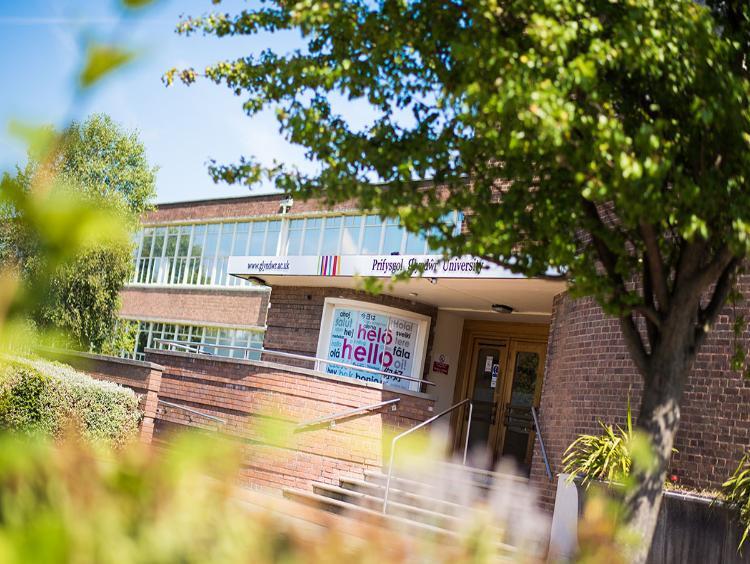
Unit of Assessment B12:
Engineering
Over 86% of research outputs were of a quality that is recognised internationally in originality, significance, and rigour, with over 9% of that figure representing world-leading research. 100% of impact case study content represented considerable impacts in terms of their significance and reach.
Impact Case Study 1: Computer Controlled Polishing and Metrology of Ultra-precision Surfaces
What is it?
Computer controlled polishing and metrology of ultra-precision surfaces is a new capability of the Precision Optical Systems Group within Glyndwr Innovations Ltd, a subsidiary company of the University.
Who was involved?
Engineering staff at The Optic Centre, Glyndwr University’s St Asaph campus.
What was done?
The Centre has developed a unique capacity to deliver highly complex optical systems components to a number of industry leading organisations within precision engineering, aerospace, and defence sectors. This capability was based on research into the manufacturing of large aspheric mirror segments for extremely large telescopes. The team continue to research and develop new polishing and metrology methods with various partners.
What was the impact?
A new, unique technological capability was developed, alongside prosperous economic impacts for collaborators and beneficiaries of Glyndwr University. The University can now fulfil the demand for high quality polishing of a range of large optics and work with industry professionals to further the technological innovations.
References to Research
Edges in CNC polishing: from mirror-segments towards semiconductors, paper 1: edges on processing the global surface.
Advanced abrasive processes for manufacturing prototype mirror segments for the world’s largest telescope
The use of diffractive imitator optics as calibration artefacts
Reconstruction of a conic-section surface from autocollimator-based deflectometric profilometry
Impact Case Study 2: Design and Manufacture of Airborne Optical Systems for High Altitude Pseudo Satellites
What is it?
Airborne optical systems are ultra-precision devices containing glass surfaces and composed of lightweight materials that are mounted onto high altitude pseudo satellites (HAPS), such as the Airbus Zephyr.
Who was involved?
Engineering staff at The Optic Centre, Glyndwr University’s St Asaph campus.
What was done?
Based on their research into designing a high resolution imaging camera for deployment on a HAPS aircraft, the team developed a novel prototype to test the space, weight, and power requirements of the craft. The prototype was subjected to rigorous testing to ensure it could withstand extreme temperatures and was light-weighted to reduce the mass.
What was the impact?
A first of its kind prototype was developed to accommodate a sensor and communications package to be mounted onto HAPS aircraft that is also compatible with other airborne platforms. Glyndŵr University has established a UK sovereign capability in the design and manufacture of optical instrumentation for high-altitude airborne persistent surveillance. This capability has led to numerous industry collaborations, such as with Ordinance Survey, QinetiQ, and Airbus.
References to Research
Development of a lightweight camera for high altitude platform systems
Outputs
Akinsolu, M. O., Liu, B., Grout, V., Lazaridis, P. I., Mognaschi, M. E., & Di Barba, P. (2019). A parallel surrogate model assisted evolutionary algorithm for electromagnetic design optimization. IEEE Transactions on Emerging Topics in Computational Intelligence, 3(2), 93-105.
Baldwin, T. C., Williams, P., & Gashua, I. B. (2016). Molecular characteristics, association and interfacial properties of Gum Arabic harvested from both Acacia Senegal and Acacia seyal.
Bolam, R. C., Vagapov, Y., Day, R. J., & Anuchin, A. (2021). Aerodynamic Analysis and Design of a Rim-Driven Fan for Fast Flight. Journal of Propulsion and Power, 37(2), 179-191.
Burr, S. J., Williams, P. A., & Ratcliffe, I. (2018). Synthesis of cationic alkylated chitosans and an investigation of their rheological properties and interaction with anionic surfactant. Carbohydrate polymers, 201, 615-623.
Chen, R., Ratcliffe, I., Williams, P. A., Luo, S., Chen, J., & Liu, C. (2021). The influence of pH and monovalent ions on the gelation of pectin from the fruit seeds of the creeping fig plant. Food Hydrocolloids, 111, 106219.
Choudhry, R. S., Hassan, S. F., Li, S., & Day, R. (2015). Damage in single lap joints of woven fabric reinforced polymeric composites subjected to transverse impact loading. International journal of impact engineering, 80, 76-93.
Evans, M., Gallagher, J. A., Ratcliffe, I., & Williams, P. A. (2016). Determination of the degree of polymerisation of fructans from ryegrass and chicory using MALDI-TOF mass spectrometry and gel permeation chromatography coupled to multiangle laser light scattering. Food Hydrocolloids, 53, 155-162.
Gao, Z., Huang, Y., Hu, B., Zhang, K., Xu, X., Fang, Y., ... & Yang, J. (2019). Interfacial and emulsifying properties of the electrostatic complex of β-lactoglobulin fibril and gum Arabic (Acacia Seyal). Colloids and Surfaces A: Physicochemical and Engineering Aspects, 562, 1-7.
Gashua, I. B., Williams, P. A., Yadav, M. P., & Baldwin, T. C. (2015). Characterisation and molecular association of Nigerian and Sudanese Acacia gum exudates. Food Hydrocolloids, 51, 405-413.
Haider, J., Majeed, H., Williams, P. A., Safdar, W., & Zhong, F. (2017). Formation of chitosan nanoparticles to encapsulate krill oil (Euphausia superba) for application as a dietary supplement. Food Hydrocolloids, 63, 27-34.
Han, L., Ratcliffe, I., & Williams, P. A. (2015). Self-assembly and emulsification properties of hydrophobically modified inulin. Journal of Agricultural and Food Chemistry, 63(14), 3709-3715.
Hu, B., Han, L., Kong, H., Nishinari, K., Phillips, G. O., Yang, J., & Fang, Y. (2019). Preparation and emulsifying properties of trace elements fortified gum arabic. Food hydrocolloids, 88, 43-49.
Kokubun, S., Ratcliffe, I., & Williams, P. A. (2018). The interfacial, emulsification and encapsulation properties of hydrophobically modified inulin. Carbohydrate polymers, 194, 18-23.
Long, S., Yang, J., Huang, X., Li, G., Shi, W., Sommerfeld, M., & Yang, X. (2020). Large-eddy simulation of gas–liquid two-phase flow in a bubble column reactor using a modified sub-grid scale model with the consideration of bubble-eddy interaction. International Journal of Heat and Mass Transfer, 161, 120240.
McMillan, A., Jones, R., Peng, D., & Chechkin, G. A. (2018). A computational study of the influence of surface roughness on material strength. Meccanica, 53(9), 2411-2436.
Ramachandran, V., Murnane, D., Hammond, R. B., Pickering, J., Roberts, K. J., Soufian, M., ... & Pencheva, K. (2015). Formulation pre-screening of inhalation powders using computational atom–atom systematic search method. Molecular pharmaceutics, 12(1), 18-33.
Shi, P., Chen, Z., Vagapov, Y., Davydova, A., & Lupin, S. (2014, September). Broken bar fault diagnosis for induction machines under load variation condition using discrete wavelet transform. In Proceedings of IEEE East-West Design & Test Symposium (EWDTS 2014) (pp. 1-4). IEEE.
Shoaib, N., Shoaib, S., Khattak, R. Y., Shoaib, I., Chen, X., & Perwaiz, A. (2018). MIMO antennas for smart 5G devices. IEEE Access, 6, 77014-77021.
Shoaib, S., Shoaib, I., Shoaib, N., Chen, X., & Parini, C. G. (2014). Design and performance study of a dual-element multiband printed monopole antenna array for MIMO terminals. IEEE Antennas and Wireless Propagation Letters, 13, 329-332.
Shoaib, S., Shoaib, I., Shoaib, N., Chen, X., & Parini, C. G. (2014). MIMO antennas for mobile handsets. IEEE Antennas and Wireless Propagation Letters, 14, 799-802.
Xu, Y., Yang, N., Yang, J., Hu, J., Zhang, K., Nishinari, K., ... & Fang, Y. (2019). Protein/polysaccharide intramolecular electrostatic complex as superior food-grade foaming agent. Glyndŵr University Research Online.



